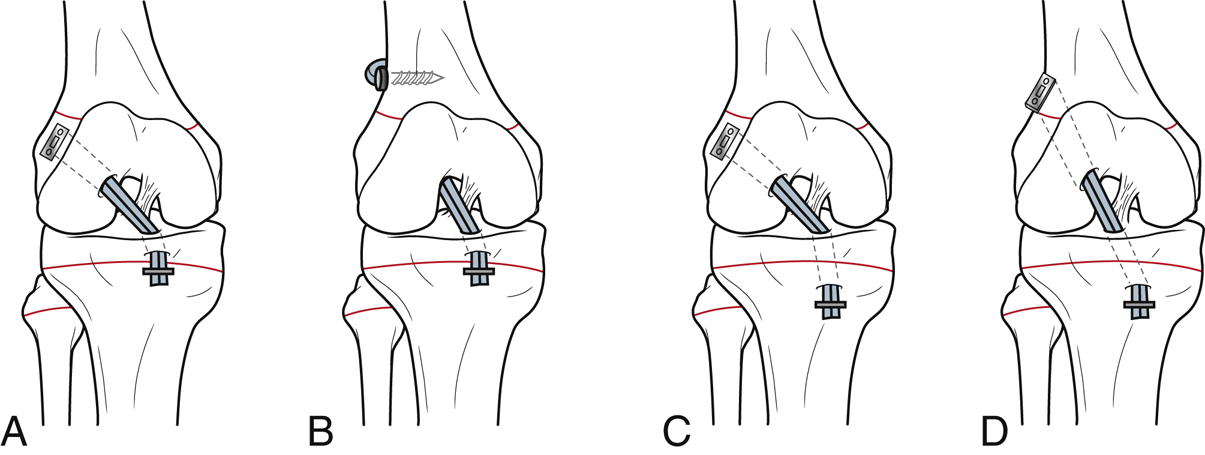Pediatric Anterior Cruciate Ligament Reconstruction
Introduction

Figure 1Illustrations show the most commonly used techniques for pediatric anterior cruciate ligament reconstruction. A, Intra-articular physeal-sparing technique. B, Partial transphyseal technique, with proximal over-the-top positioning of the graft (authors’ preference). C, Partial transphyseal technique, with all-epiphyseal proximal tunnel drilling. D, Complete transphyseal technique.
Treatment of anterior cruciate ligament (ACL) tears in patients with open physes remains controversial
Pediatric ACL injuries have increased 2.3% annually from 1994 to 2013
Surgical timing—Early versus delayed reconstruction
Benefits of early treatment—May improve knee function, avoid strict activity modification in competitive athletes, and reduce progressive chondral and meniscal injury
Benefit of delayed treatment—May avoid potential growth disturbances
Surgical technique (Figure 1)
Physeal-sparing technique
Intra-articular, extra-articular, and combined
Extra-articular and combined are nonanatomic; associated with poor outcomes
Complete transphyseal technique is comparable to adult-type reconstruction
Direct repair has had inferior outcomes compared with reconstruction
Rigid fixation for tibial spine avulsions; reconstruction of ACL is contraindicated in these cases
| Video 20.1 Pediatric Anterior Cruciate Ligament Reconstruction. Davide Edoardo Bonasia, MD; Roberto Rossi, MD; Brian R. Wolf, MD; Annunziato Amendola, MD (18 min) |
Patient Selection
Clinical examination
History—Audible pop, rapid-onset hemarthrosis
Mechanism—Flexion-valgus-external rotation is most common
Evaluate joint effusion, point tenderness, range of motion (ROM), and instability
Perform Lachman, drawer, pivot-shift, and varus/valgus stress tests
Conservative treatment
Includes ROM exercises, strengthening, functional braces, and activity modification
Conservative management should be discussed in all cases, especially for inactive patients
Surgical indications
Failure of conservative treatment with persistent effusion, pain, instability
Patient is unwilling or unable to modify activity levels
Meniscal tear is associated with ACL tear.
Patient age
In older adolescents (females older than 14 years; males older than 16 years), a complete transphyseal technique can be used
In younger patients (females younger than 14 years; males younger than 16 years), technique selected based on surgeon preference
Authors’ preference—Partial transphyseal technique with proximal over-the-top positioning of semitendinosus tendon autograft
Preoperative Imaging
Radiography
AP, lateral, Merchant, and tunnel views of bilateral knees
To evaluate the physis for remaining growth
To rule out
Tibial and/or femoral epiphyseal fractures
Tibial spine avulsions
Malformation of tibial spine and/or femoral notch
Magnetic Resonance Imaging
To visualize ACL tear and location of injury
Stay updated, free articles. Join our Telegram channel

Full access? Get Clinical Tree


